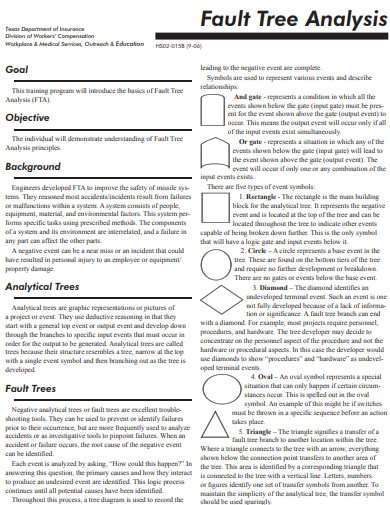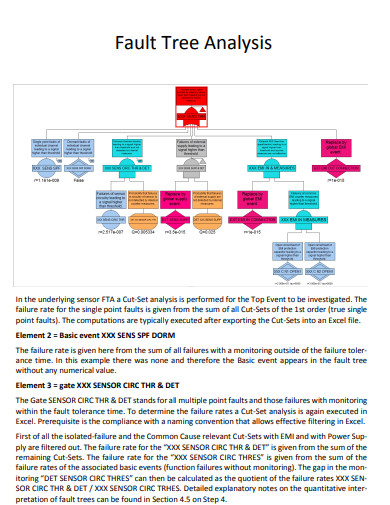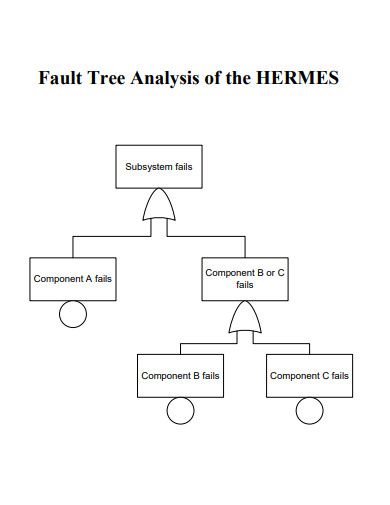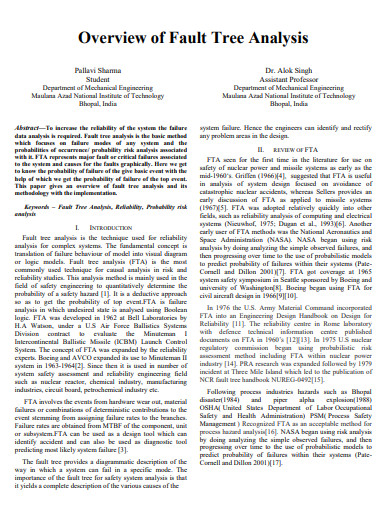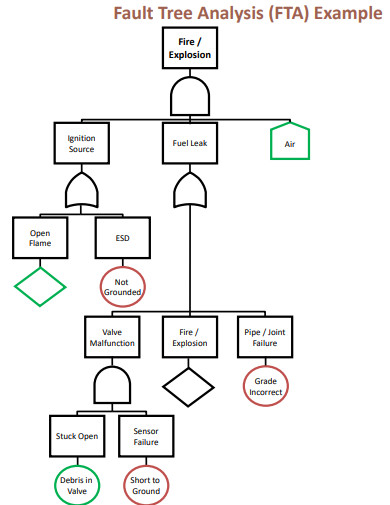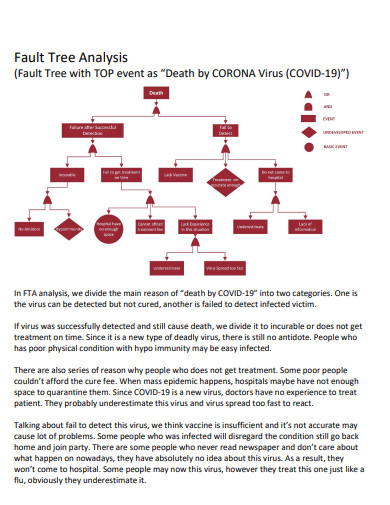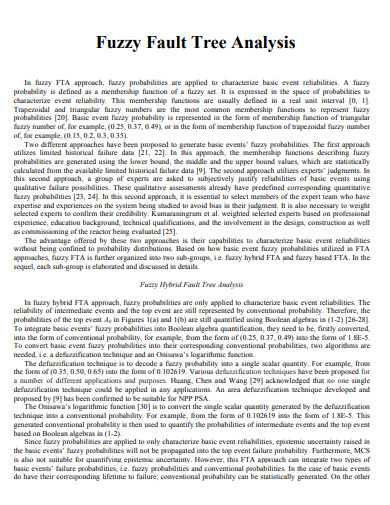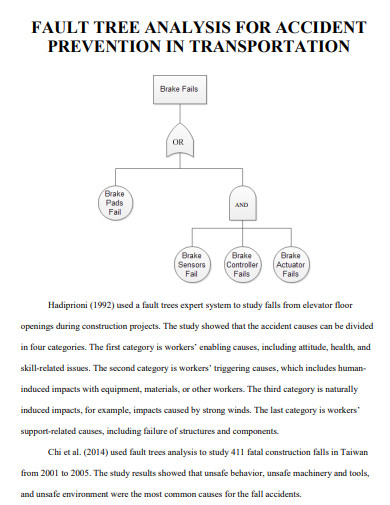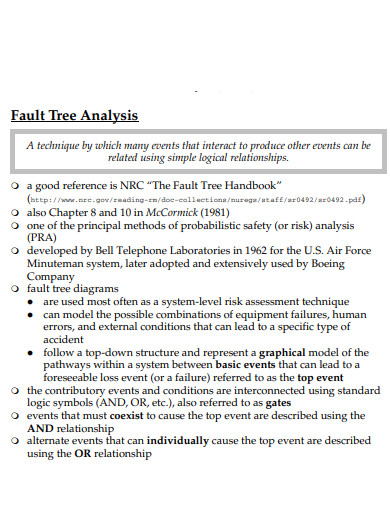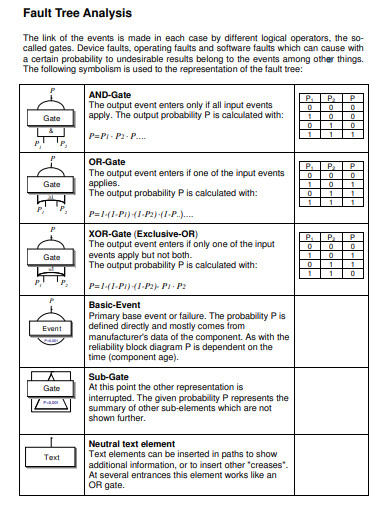The basic structure of a fault tree is a tree diagram that begins with a specific undesired event or “top event”, such as a nuclear accident or a quantitative chemical release, and branches out to show all the possible sample events that could lead to that top event. The branches represent the various causes of the top event, and each branch is then further divided into sub-causes.
10+ Fault Tree Analysis Samples
1. Fault Tree Analysis
2. Sample Fault Tree Analysis
3. Basic Fault Tree Analysis
4. Fault Tree Analysis of the HERMES
5. Overview of Fault Tree Analysis
6. Fault Tree Analysis Example
7. Corona Virus Fault Tree Analysis
8. Fuzzy Fault Tree Analysis
9. Fault Tree Analysis for Accident
10. Fault Tree Analysis Template
11. Standard Fault Tree Analysis
What is Fault Tree Analysis?
Fault Tree Analysis (FTA) is a method used to identify and analyze the possible failures and their causes in a complex system, such as a nuclear power plant or a chemical processing facility. It is a graphical representation of all the events that could lead to a specific undesired event risk or top event, such as a nuclear accident or a chemical release. The tree structure allows analysts to identify and evaluate the probability and impact of each event, and to identify and prioritize actions to mitigate risk. It is commonly used in safety-critical industries such as aerospace, nuclear power, and chemical manufacturing business to identify and evaluate potential hazards and to develop industrial safety measures to reduce risk.
How To Make a Fault Tree Analysis?
The analysis begins by identifying the top event and working backwards to identify the causes and sub-causes. The probability and impact of each event are evaluated, and actions are identified and prioritized to mitigate the risk of the top event occurring. Here is a general process for conducting a Fault Tree Analysis:
Step 1- Define Top Event
The first step in creating a fault tree is to define the top event, which is the undesired event that the analysis is intended to prevent. Basic events are the events that directly contribute to the top event. Identify the basic events that could lead to the top event, and then organize them into a logical structure.
Step 2- Develop the Fault Tree
Begin with the top event and work backwards, connecting the basic events to the top event with logical gates, such as AND, OR, and NOT gates. Each gate represents a logical relationship between the events. Assign probabilities to each basic event and gate. The probabilities are used to calculate the probability of the top event occurring.
Step 3- Identify the Failures
Look for common-cause failures, which are failures that affect multiple systems or components simultaneously. Create event trees, which are diagrams showing the progression of events leading to the top event. Identify the critical event that initiated the sequence of events leading to the top event.
Step 4- Identify Actions
Identify actions that can be taken to mitigate the risk of the top event occurring, and prioritize them based on their effectiveness and cost. Review the fault tree to ensure that it accurately reflects the system and that all potential failures have been identified. Update the fault tree as needed to reflect changes in the system or new information.
What industries commonly use Fault Tree Analysis?
Fault Tree Analysis is commonly used in safety-critical industries such as aerospace, nuclear power, and chemical manufacturing to identify and evaluate potential hazards and to develop safety measures to reduce risk.
What is the basic structure of a fault tree?
The basic structure of a fault tree is a tree-like diagram that begins with a specific undesired event or “top event”, such as a nuclear accident or a chemical release, and branches out to show all the possible events that could lead to that top event. The branches represent the various causes of the top event, and each branch is then further divided into sub-causes.
What are the benefits of Fault Tree Analysis?
The benefits of Fault Tree Analysis include its ability to identify and prioritize potential hazards, identify common-cause failures, and create event trees. These features allow for the reduction of risk in safety-critical industries.
In conclusion, Fault Tree Analysis is a valuable tool for identifying and analyzing potential failures in complex systems. Its ability to identify and prioritize potential hazards, identify common-cause failures, and create event trees make it an important tool for reducing risk in safety-critical industries.
Related Posts
FREE 10+ Analysis of Alternatives Samples in PDF
FREE 10+ Failure Mode and Effects Analysis Samples in PDF
FREE 10+ Make or Buy Analysis Samples in PDF
FREE 10+ Fishbone Root Cause Analysis Samples in PDF
FREE 11+ Cost Volume Profit Analysis Samples & Templates in PDF | MS Word
FREE 6+ Corporate Portfolio Analysis Samples in PDF
FREE 10+ Comp Analysis Samples in PDF
FREE 10+ Fishbone Analysis Samples in PDF
FREE 10+ Individual Swot Analysis Samples in PDF
FREE 10+ 5 Year Analysis Samples in PDF
FREE 10+ Benefit Costs Analysis Samples in PDF
FREE 10+ Job Hazard Analysis Samples in PDF
FREE 10+ Primary Source Analysis Samples in PDF
FREE 10+ Critical Path Analysis Samples in PDF
FREE 10+ Competition Analysis Samples in PDF

